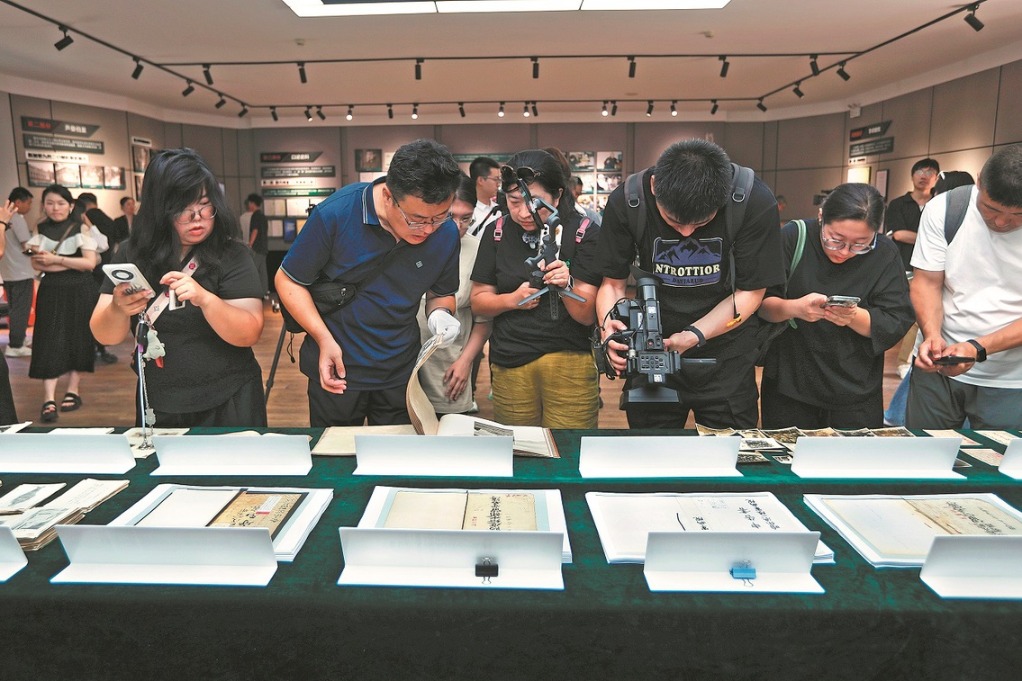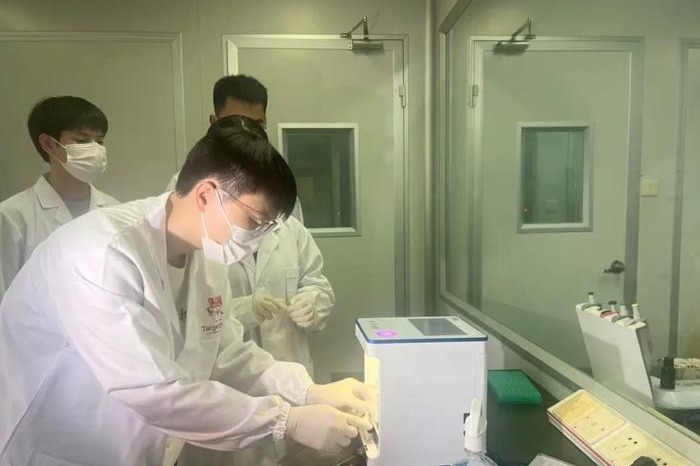Old-style social media
Rock paintings were the means by which our early ancestors kept in touch on the whereabouts of their prey, Yang Feiyue reports.

Zhou Xingkang had a few close calls during his recent quest to find out more about the ancient rock paintings and prehistoric culture in Haizishan, Garze Tibetan autonomous prefecture, Southwest China's Sichuan province.
"Some places were really hard to reach, and we had to ride a motorcycle along a precarious path, with a steep cliff on one side," Zhou says.
Zhou's motorcycle stumbled once, as a thermos hanging on the handrail fell and got among the wheel spokes. "I was lucky as the motorcycle crashed on the non-cliff side."
The bumpy journey lasted for about seven hours each day, and any slip would likely lead to a more permanent conclusion.
"It was hard, even for me, considering I had decades of mountain hiking experience," Zhou says, adding that he had trouble standing straight at the end of the ride.
Chance beginning
It was curiosity that prompted Zhou, who is in his 50s, to embark on the five-day expedition for the ancient art, led by the Haizishan management committee in the region at the end of June. He was intrigued by the initial findings from authorities' general survey of primitive rock paintings.
Over the past six years, the committee has conducted a series of field investigations to study the rock paintings and explore the local human heritage to better tap into the cultural and tourism resources, according to Sun Kangshou, director of the committee.
Zhou was invited on the journey for his commitment to rock paintings exploration on the plateau since 2016.
Zhou's interest in this prehistoric legacy was sparked when he stumbled upon some rock paintings, when he was working at a welfare foundation that helped build schools and rural hospitals in Ngari prefecture, Southwest China's Tibet autonomous region.
"On my way to the Rutog county in the region, I often saw paintings on the rocks, which locals didn't know the meaning of," Zhou says.
This piqued his curiosity.
When he quit his job with the foundation in 2014, due to health issues, he decided to learn more about the rock paintings.
"I read up on them in related photo albums and monographs and I was deeply touched," he says.
It prompted him to start his own exploration of the ancient art form in Tibet. He further expanded his reach into the western, central and northern parts of the Qinghai-Tibet Plateau, where he had hiked in previous years, including on Mount Qomolangma, known as Mount Everest in the West, in 2003.
Field expert
In studying the known rock paintings and looking for new ones, all the while consulting experts in the field, Zhou has become something of an expert himself and he has acquired a good understanding of what motivated the mysterious painters.
"Rock paintings are distributed in areas where hunting was possible and they exhibit certain geographic characteristics," Zhou says.
For example, areas around wetlands are very likely to have rock paintings, he says.
He also discovered that if a significant rock painting site is found, it is highly likely there will be another one within a range of 50 to 60 kilometers.
"This is because the game moved around, and the paintings served to mark their whereabouts accordingly," Zhou explains.
This led Zhou to discover several exciting ancient rock painting sites in a number of places, including one in Gegyai county in Ngari.
"I felt proud and a great sense of achievement, since the site in Gegyai had not been documented by the local cultural relic department," Zhou says.
The rock paintings he found near the Xiangquan (Langqen Zangbo) River, in Zanda county of Ngari, surprised him with patterns resembling wheels, houses and human figures.
"The river valley was very narrow, not suitable for permanent living, but the human presence suggested its role as an important route in the ancient times," Zhou says.
Although it was known that the river was an important passageway from the west of Tibet to the north of India, seeing evidence of it "sent a thrill down my spine", he says.
At the moment, Zhou is sorting out his findings and plans to share them with scholars in the field.
"I plan to publish a photo album about rock paintings on the Qinghai-Tibet Plateau, maybe also build a website and write a book afterward," Zhou says.
There are still many things he says he wants to explore, like how the horses and sheep first came to the plateau and how various funeral rites came into being.
New discoveries
During the recent rock painting quest, Zhou and the rest of the team traversed high mountains and deep valleys, while overcoming the difficulties caused by high altitude and lack of oxygen.
Building on the preliminary investigation, on the recent trip, the team managed to discover six prehistoric rock painting sites in an area of approximately 1,800 square kilometers, encompassing high-altitude wasteland, grassland, wetland and river valley. Among them, five are located at an altitude above 4,600 meters, only the one situated in a river valley is at an altitude lower than 3,700 meters.
Zhou and his teammates then conducted on-site photography, collected geographical information including the topography, landforms and vegetation distribution related to the discovered sites.
The rock paintings are all painted with red pigments and depict various animals such as large deer and mountain goats, as well as anthropomorphic figures holding objects and wild animal claw prints.
"Rock paintings are traces left by early humans during hunting and are among the earliest conscious creations by humans," says Zhang Yasha, professor from the China rock art center with Minzu University of China. The center was one of the organizers of the expedition.
"The newly discovered rock paintings in the Haizishan region exhibit many stylistic features reminiscent of prehistoric rock paintings, in terms of the themes, image sizes, pattern characteristics and painting techniques, and they may be related to the unique rock art clusters of the Paleolithic era in Southwest China," Zhang says.
She believes those rock paintings are the first of their kind that have been found so far in Sichuan, and antedate most of the rock paintings found on the plateau before.
"They will play an important role in updating our understanding of rock art in the Qinghai-Tibet Plateau," Zhang says.
She says further study and analysis will be conducted on the content of the Haizishan rock paintings in collaboration with relevant departments in Garze.
Zhou was impressed by the sophistication of the paintings.
"Most rock paintings we find are sculpted into the rock and represent abstract symbols, but the new ones were drawn, which is rare on plateau, and they depict evident hunting elements, with distinctive wild animals," says Zhou, who has conducted field investigations at over 150 independent rock painting sites on the Qinghai-Tibet Plateau.
Moreover, the images are much bigger than his previous finds, with some animal figures being 2 meters high. "It shows the ancient put in more efforts in those paintings," Zhou says.
The majority of the Haizishan rock paintings in Garze are located at altitudes above 4,600 meters, which is different from the typical distribution of previously found rock carvings on the plateau, mostly at altitudes ranging from 4,000 to 4,400 meters.
Therefore, Zhou holds that the ancient population behind these discovered painted rock art sites should provide unique insights for the study of prehistoric life on the Qinghai-Tibet Plateau.
"These ancient people lived at higher altitudes, but the reason for their hunting during the Paleolithic period could be attributed to the relatively warmer climate at that time," he explains.
"It is even observed that several of the identified locations no longer have grazing areas, while these rock paintings should serve as markers indicating the presence of game, serving as reminders for both themselves and future generations. They provide new avenues for understanding our ancient past," he adds.
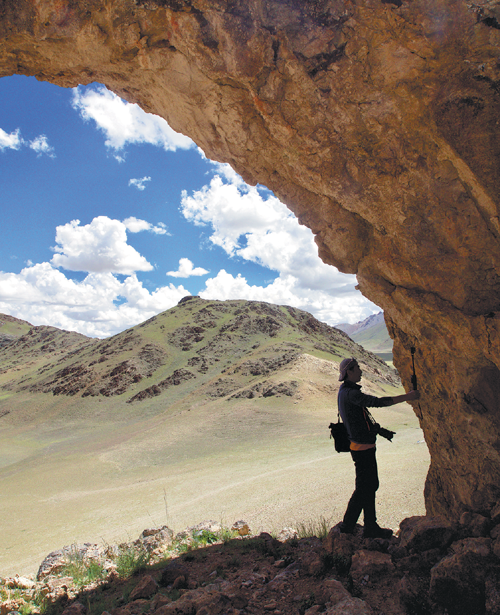
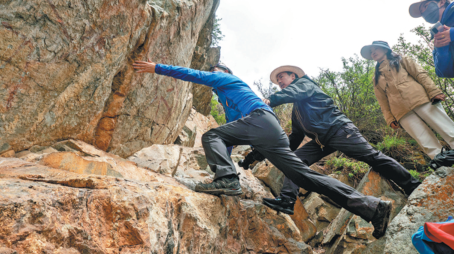
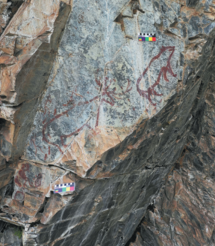
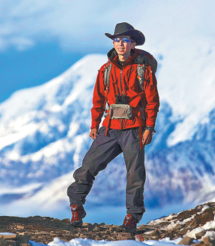
Today's Top News
- China holds 2nd rehearsal for event marking 80th anniversary of victory over Japanese aggression, fascism
- Foreign athletes embrace culture, innovation at Chengdu World Games
- Meet again? Putin says: Next time in Moscow
- Zelensky to meet Trump in Washington on Monday
- Wang Yi to visit India from Monday
- Trump, Putin tout 'productive' Alaska talks without apparent breakthrough
















